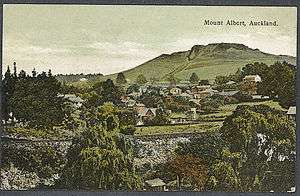Mount Albert (New Zealand)
Mount Albert (Māori: Ōwairaka or Te Ahi-kā-a-Rakataura) is a volcanic peak which dominates the landscape of Mount Albert, a suburb of Auckland.
| Mount Albert | |
|---|---|
| Ōwairaka or Te Ahi-kā-a-Rakataura | |
 Mt Albert volcano in the Mt Albert suburb. | |
| Highest point | |
| Elevation | 135 m (443 ft) |
| Coordinates | 36.8841°S 174.7156°E |
| Geography | |
| Location | North Island, New Zealand |
| Parent range | Auckland volcanic field |
| Geology | |
| Volcanic arc/belt | Auckland volcanic field |
Etymology
Mount Albert was named after Queen Victoria's consort, Prince Albert, following a petition in 1866 to the Superintendent of Auckland Province, Frederick Whitaker.[1]
The main Māori name of the peak is Ōwairaka, which means 'Place of Wairaka'; she was the daughter of Toroa, the commander of one of the great voyaging canoes, Mātaatua.[1] Wairaka is renowned for naming Whakatane, a town in the Eastern Bay of Plenty where she saved the waka from drifting out to sea. Wairaka subsequently moved to Tamaki-Makaurau to avoid an arranged marriage and set up her own pā at Ōwairaka.[2]
The Māori name Te Ahi-kā-a-Rakataura refers to the Tainui priest Rakataura aka Hape.[3]
Geography

The peak, in parkland at the southern end of the suburb, is 135 metres (443 ft) in height, and is one of the many extinct cones which dot the city of Auckland, all of which are part of the Auckland volcanic field. The age of the volcano is currently unknown. The peak was formerly the site of a Māori pā, a fortified settlement. Extensive quarrying has reduced the height of the scoria cone by about 15 metres (49 ft) and significantly altered its shape, but a few remnants of Māori earthworks such as terracing are still visible.
Current uses of the cone include several playing fields, an archery club and a 31,500 cubic metres (1,110,000 cu ft) water reservoir buried in a paddock on the mountain's southern side.
Treaty settlement
In the 2014 Treaty of Waitangi settlement between the Crown and the Ngā Mana Whenua o Tāmaki Makaurau collective of 13 Auckland iwi and hapu (also known as the Tāmaki Collective), ownership of Ōwairaka / Te Ahi-kā-a-Rakataura / Mount Albert was vested to the collective. It is now co-governed by the collective and Auckland Council through the Tūpuna Maunga o Tāmaki Makaurau Authority in common benefit of the iwi "and all other people of Auckland".[4][5]
Vehicle access
Due to the spiritual and cultural significance of the maunga (mountain) to Māori the summit road was permanently closed to most vehicles in March 2019.[6]
Native tree regeneration
As part of a large works plan to regenerate the maunga, the Tūpuna Maunga Authority plans to remove 345 exotic trees and plant 13,000 new native trees and shrubs. 183 of the exotic trees are classified as pest or weed species. The work has Resource Consent, the support of ecologists, arborists, Auckland Council, the Tree Council, Forest and Bird and the Tāmaki Collective. In November 2019 a group of protesters blocked the removal of exotic trees, voicing concerns for fauna.[7][8]
References
| Wikimedia Commons has media related to Mount Albert (New Zealand). |
- Reed, A. W. (2010). Peter Dowling (ed.). Place Names of New Zealand. Rosedale, North Shore: Raupo. p. 255. ISBN 9780143204107.CS1 maint: ref=harv (link)
- Dunsford, Deborah. "Wairaka, heroine of her time". Mt Albert Inc. Mt Albert Historical Society. Retrieved 14 November 2019.
- "Walking About: Pīta Turei, Te Wai o Rakataura". Our Auckland. Auckland Council. Retrieved 10 January 2020.
- "Ngā Mana Whenua o Tāmaki Makaurau Collective Redress Act 2014". New Zealand Legislation. Retrieved 25 October 2014.
- "Tūpuna Maunga o Tāmaki Makaurau Authority". Auckland Council. Retrieved 4 January 2020.
- "Changes to vehicle access on Tūpuna Maunga". Auckland Council. Retrieved 4 January 2020.
- "Ōwairaka / Mount Albert Trees". waateanews.com. Retrieved 4 January 2020.
- "Meet the activists trying to stop native trees being planted on Mt Albert". Newshub. Retrieved 4 January 2020.
- Volcanoes of Auckland: A Field Guide. Hayward, B.W.; Auckland University Press, 2019, 335 pp. ISBN 0-582-71784-1.
External links
- Photographs of Ōwairaka held in Auckland Libraries' heritage collections.